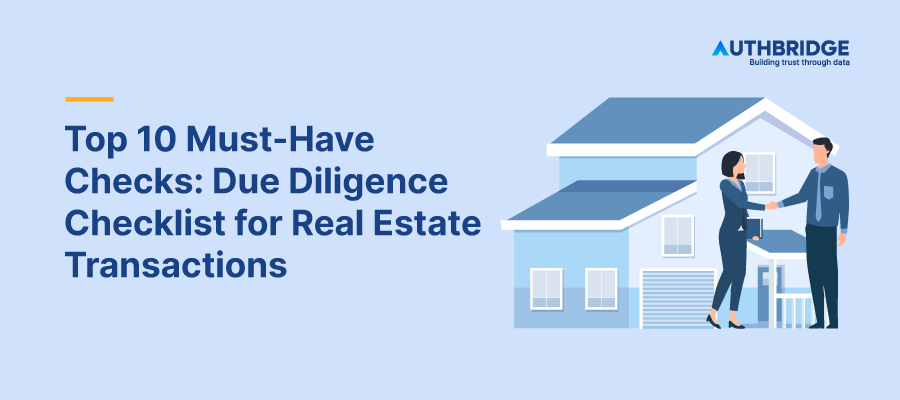Introduction
Real estate transactions in India involve substantial financial investments, making due diligence an indispensable part of the buying process. Effective due diligence helps identify potential risks and validate the property’s legal standing, physical condition, and market value.
Importance of Due Diligence in Real Estate:
In the complex landscape of Indian real estate, due diligence ensures that investors and buyers avoid legal pitfalls, financial losses, and fraudulent transactions. It provides a thorough understanding of the property’s status and future potential, safeguarding the buyer’s interests.
1. Legal Title Verification
Assessing Title Documents
To ensure a property’s legal integrity, it’s critical to verify that the seller has an indisputable and marketable title. This involves examining all documentation related to ownership and title deeds. It’s essential to ensure that the title deeds clearly outline the seller’s right to sell and that there are no ambiguities that could later lead to legal disputes.
- Key Documents: Title deeds, succession certificates, and sale deeds.
- Historical Verification: It is recommended to trace the title back for at least the last 30 years to ensure there are no historical claims or disputes years to ensure there are no historical claims or disputes.
History of Ownership
A comprehensive review of the property’s ownership history helps identify any potential legal issues or claims that might not be apparent from current documents alone. This historical perspective can reveal patterns or disputes that are critical to address before proceeding with the transaction.
- Previous Disputes: Look for any legal disputes involving past owners that could affect the property.
- Chain of Ownership: Ensure that the chain of ownership is clear and uninterrupted, with no gaps in the recorded history.
2. Encumbrance Check
Searching for Liens and Encumbrances
An encumbrance check is vital to ascertain that the property is not mortgaged and is free from any legal dues or claims that might impact the buyer’s rights. This check involves reviewing the Encumbrance Certificate, which lists all registered transactions related to the property.
- Encumbrance Certificate: Obtain this certificate for at least the last 30 years from the sub-registrar’s office where the deed is registered.
Encumbrance Certificate
The Encumbrance Certificate is crucial for verifying that there are no current claims, liens, or legal complications tied to the property. This document provides a legally acknowledged insight into the property’s financial and legal history.
- Clear Title: A clear encumbrance record strengthens the property’s marketability and reduces the risk of future legal complications.
3. Land Use Verification
Checking Zoning Regulations
Confirming the zoning regulations and compliance with municipal guidelines is crucial to understanding the permissible uses of the property. This verification helps ensure that the property’s intended use is in line with local regulations, preventing potential legal issues down the line.
- Zoning Compliance: Verify against local municipal records to ensure the property meets the zoning criteria for its intended use.
Compliance with Local Laws
Ensuring that the property complies with all regional and national development plans is vital for long-term security and usability.
- Development Regulations: Check for any specific restrictions or allowances that may affect property usage, such as height restrictions or designated commercial or residential areas.
4. Building Approvals and Permits
Sanctioned Building Plans
Verifying that all building plans have been approved by the local municipal corporation is essential. Unauthorized or non-compliant structures can lead to legal actions including penalties or, in extreme cases, demolition orders.
- Approval Documents: Ensure that all constructions on the property have been approved and are in accordance with the sanctioned plans.
Construction Permits
All necessary construction permits must have been obtained from the relevant authorities. This check is crucial to ensure that the building complies with all local safety norms and construction codes.
- Permit Verification: Cross-checking permits with local government records can ensure compliance and prevent future legal challenges.
5. Property Tax Receipts
Verification of Tax Payments
Ensuring that all property taxes have been paid up-to-date is crucial in the due diligence process. Unpaid taxes can result in liens against the property, affecting the new owner’s rights and responsibilities.
- Tax Receipts: Request and review the latest tax receipts and any backlogs. This verifies that the seller has fulfilled all tax obligations up to the date of sale.
- Tax Assessment Records: Checking these records can reveal the tax history and any outstanding liabilities that might not be immediately apparent.
Assessment of Tax Liabilities
Identifying any pending tax liabilities before the transaction can prevent future legal and financial complications. It’s essential to confirm that there are no hidden tax dues that could transfer to the new owner.
- Local Municipality Consultation: Engaging with local tax authorities can provide an official confirmation of the property’s tax status and any anticipated reassessments.
6. Physical Survey of Property
Conducting a Site Visit
A physical inspection of the property is indispensable to verify its condition, boundaries, and compliance with described features in official documents. This step helps identify any discrepancies between the listed and actual state of the property.
- Site Condition Report: Document the property’s physical condition, noting any repairs or maintenance issues that could affect its value or usability.
- Boundary Verification: Ensure that the property boundaries are clearly marked and correspond with those described in the title deeds and other documents.
Verification of Area and Layout
Confirming that the physical dimensions and layout of the property match those on paper is another critical step. Discrepancies here can lead to disputes or require adjustments in the property valuation.
- Surveyor’s Report: Hiring a professional surveyor to measure the property can provide an accurate confirmation of its size and layout, ensuring they align with the sale agreement and other legal documents.
7. Utility Access and Infrastructure
Availability of Essential Utilities
Verifying the availability and functionality of essential utilities such as water, electricity, sewage, and internet connectivity is crucial for assessing the property’s livability and operational readiness.
- Utility Statements: Review recent utility bills and service records to ensure there are no outstanding issues or disruptions that could affect the property’s functionality.
Infrastructure Quality
The quality of infrastructure, such as roads, drainage systems, and public services, directly impacts property value and usability. Poor infrastructure can lead to increased maintenance costs and lower property attractiveness.
- Infrastructure Audit: An inspection of the infrastructure by qualified professionals can determine its condition and adequacy for supporting the property’s needs.
8. Environmental Assessments
Environmental Clearances
For properties that require compliance with environmental regulations, verifying that all necessary environmental clearances have been obtained is vital. This ensures the property is not subject to future legal actions or restrictions due to non-compliance.
- Clearance Certificates: Collect and verify all environmental clearance certificates issued by local or national environmental agencies.
Risk of Natural Disasters
Understanding the property’s susceptibility to natural disasters like floods, earthquakes, or landslides is essential for assessing potential risks and insurance needs.
- Disaster Risk Report: Consulting geological surveys and disaster risk assessments can provide insight into any environmental hazards associated with the property.
9. Future Development Plans
Government and Private Projects
Knowledge of any upcoming government or private development projects in the area can significantly influence property values and decision-making. Positive developments might increase value, while certain projects (like new industrial areas) might decrease residential property desirability.
- Local Development Authority: Checking with the local development authority for upcoming projects provides foresight into potential changes in the area’s landscape and property values.
Area Development Plans
Understanding planned infrastructural or zoning changes by local authorities can impact the property’s future usability and worth.
- Planning Documents: Review comprehensive development plans from local planning authorities to ascertain future developments that could affect the property.
10. Market Value Assessment
Appraisal of Property Value
Conducting a formal appraisal by a certified real estate appraiser gives an unbiased estimate of the property’s market value, essential for both buyer and lender.
- Comparative Market Analysis: This analysis helps validate the asking price by comparing it with similar properties recently sold in the area.
Comparison with Nearby Properties
Analyzing the sale prices and features of comparable nearby properties ensures the buyer is paying a fair market price and provides a benchmark for negotiating the sale price.
- Real Estate Market Trends: Understanding current market trends helps in assessing whether the property is likely priced appropriately for its location and condition.
Conclusion
This comprehensive due diligence checklist for real estate transactions provides potential buyers with the necessary framework to ensure a secure and informed property purchase in India. Each step is designed to uncover critical details that could affect the value, legality, and suitability of the property, safeguarding the buyer’s investment against unforeseen issues and disputes.






